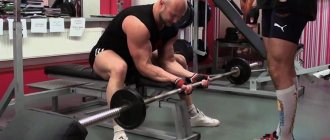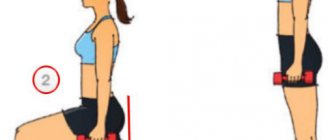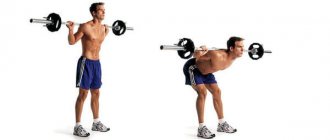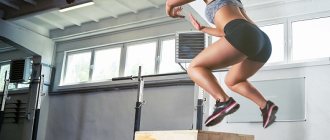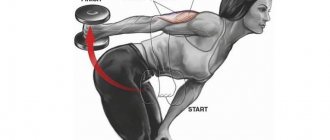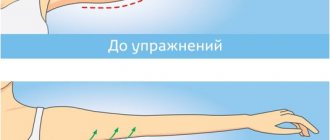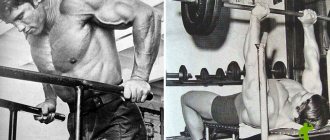Author: Timko Ilya - the ruler of the entire site and fitness trainer | more details >> Rod. 1984 Trained since 1999 Trained since 2007. Author and creator of the site tvoytrener.com. CCM in powerlifting. Champion of Russia and South Russia according to AWPC. Champion of the Krasnodar region according to IPF. 1st category in weightlifting. 2-time winner of the Krasnodar Territory championship in t/a. Author of more than 700 articles on fitness and amateur athletics. Author and co-author of 5 books.
Place in the ranking of authors:
out of competition
(become an author)
Date:
2012-05-29
Views:
445 131
Rating:
5.0
| All articles by the author >> | Medals articles >> |
Articles are loading...
| Article medals: | more than 100 thousand views |
Why medals are given to articles:
| Bronze medal: | |
| 1. The article is in the TOP 100 2. The article has more than 3. The article has more than 100 | |
| Silver medal: | |
| 1. The article is in the TOP 50 2. The article has more than 3. The article has more than 500 | |
| Gold medal: | |
| 1. The article is in the TOP 10 2. The article has more than 1 3. The article has more than 1,000 | |
Primary muscles - gluteus maximus and quadriceps femoris Additional - posterior thigh Difficulty - medium
Execution technique
Initial position
- The barbell is located on racks at the level of the athlete’s collarbones;
- The athlete takes it from the racks in one movement, bringing the body under the bar;
- The projectile is located on the trapezius muscles as conveniently as possible;
- If the goal is to work the quadriceps, you should hold your body more vertically and place the barbell higher;
- If there is more emphasis on the gluteals, the bar should be moved lower and a slight bend forward;
- Moving away from the racks resembles the same movement performed in a high-pants or low-pants squat variation;
- The athlete takes 2 steps back and places his feet wider than his shoulders.
Movement
- You need to take one step forward so that your hips determine the width of your feet;
- Next, we lower ourselves into a split squat, the knee of the front leg should be higher than the hip bone;
- The lower leg is perpendicular to the floor, or close to this angle;
- Full lowering is performed, to the maximum possible amplitude and lifting for a person
It's BAR LUNCHES, baby!
Attention
- Lowering the head and looking down leads to disruption of the trajectory of the projectile and possible injuries;
- You should refrain from rounding your back in both the thoracic and lumbar regions;
- The shoulder blades should be collected towards the spine;
- The exercise should not be performed so that the knee is “sharp” and the body rests on the thigh;
- You need to stand up in one movement, without lifting your buttocks;
- The work should be uniform, the length of steps on both sides should be the same;
- Even if an athlete is using light weights, resting the bar on the neck is a poor strategy and can lead to injury.
Technique for performing front squats with a barbell on the shoulders
Athletes often refuse to do squats with weights on the front due to an unusual grip and fear of the apparatus falling during execution. Therefore, before starting a front squat, it is recommended to master the technique of correct bar placement and body position.
Features of the front grip during a front squat
At the initial stage of training, it is advisable to use not an Olympic bar, which weighs 20 kg, but a lighter weight: a bar with less weight or a gymnastic stick.
During a front squat, the barbell is held with grips in 2 options: classic and cross.
The classic grip looks like this. With the arms parallel to each other, the hands are placed under the bar so that the palms look up. This grip is sometimes called a hook grip. It is carried out mainly with the fingers and is not completely closed.
X
First you need to learn how to hold a light weight in this way, placing it slightly below the level of the collarbones. After this, you can move on to training with an Olympic bar. When you can hold it with a hook grip, you can begin front squats with a barbell.
If the projectile is taken with a cross grip, it is placed on pre-straightened arms, which are crossed on the bar to avoid tipping forward.
X
Step-by-step front squat technique
It is recommended to squat with weights on your chest in a power rack. You need to install the bar at such a height that it rests on the deltoids, that is, at shoulder level.
When you approach the bar, you need to sit slightly under it. Bringing your elbows forward (the palms themselves will take the desired position), remove the barbell, place it at the level of the front deltas and take it with a classic or cross grip.
After making sure that the position of the projectile is stable, straighten your knees and take the starting position. Feet are placed shoulder-width apart or slightly wider with toes pointed out to the sides. Your knees should point toward your toes. To maintain balance, keep your elbows parallel to the floor. The back maintains a stable, level position.
It is unacceptable to transfer your body weight to your toes: this will lead to the projectile tipping over.
- As you inhale, due to flexion at the knee joint, you begin lowering into a squat. If possible, it is recommended to squat deeply until your thighs touch your calves.
- Due to the strength of the leg muscles, they lift up, pressing the heels into the floor. The most difficult part of the amplitude is accompanied by exhalation. In the top position, do not allow your knees to lock: this will reduce tension in the target muscles and unnecessarily load the joints.
Do 8-12 repetitions in 3-4 sets.
With
The gaze should be directed forward or slightly upward. All movements are made smoothly, without jerking. They lower into a squat slower than they rise.
Recommendations
- Touching the floor with your standing foot from behind is allowed only if it is soft; you should not hit the kneecap on the floor;
- The movement should be quite deep, especially if the goal is to pump up the gluteal muscles;
- The core and abs should be kept tense in order to maintain the full anatomical relief of the spine;
- It is necessary to check the position of the shin of the leg that is in front. If it does not correspond in any way with the perpendicular, the position should be changed, because this position is dangerous for the ACL
Execution options
- Walking lunges . This option consists in the fact that the exercise is not performed alternately with the right and left legs, but as if constantly. The athlete steps forward, constantly moving the leg forward and alternating legs. This movement is mistakenly considered an exercise for the buttocks; in fact, the load is evenly distributed between the gluteal muscle and quadriceps. But what this exercise really does is burn a lot of energy. The movement is very energy intensive, and therefore it is used for all cases where it is necessary to expend a large number of calories. In addition, a walking lunge can be a good option for developing running speed and step depth;
- Front lunges with barbell . They differ in that the barbell is taken by the athlete on the clavicle bones, the hands are positioned as with a barbell in a front squat, that is, either crosswise or with raised elbows and wrists. The peculiarity of the frontal hold of the projectile is that it does not give the athlete;
- Sitting in different strides . In this version of the lunge, you do not need to return to the starting position every time, placing one foot next to the other. A split squat is performed, that is, a lunge forward, and all repetitions are in this position, and only then the leg is placed. This option is more convenient for those people who perform workouts with heavier weights.
- Long stride movement . This option is used by those who want to make their buttocks a priority. Long stride lunges are not powerful and require a moderate amount of effort to do them. Typically, the long stride movement is performed in a split manner so that the athlete does not overload the muscles.
Lunges with a barbell: execution technique
Analysis of the exercise
What muscles work
Main : quadriceps and gluteus maximus
Auxiliary : the entire array of thigh muscles plus the gastrocnemius, soleus, and core as a stabilizer. The hamstrings work in this exercise the more, the wider the step is. The movement also loads the spinal extensors, especially if they are actively involved when bending over, and the exercise is performed with a low barbell
Advantages
- This is a unilateral exercise that allows you to get rid of asymmetry in the body. It works well not only in the absence of leg stall in deadlifts and weak squats, but also for aesthetics. People by nature are not very symmetrical; sometimes it is visually clear that a person has hips and buttocks of different sizes, and then unilateral exercises come to the rescue. In addition, they allow you to become stronger by objectively increasing the load on the muscles. They are also more useful during the rehabilitation period and for people with spinal injuries due to the fact that they can be used with lighter weight;
- Improves balance and allows you to move more coordinated. Because of this, they contribute to the activation of motor reflexes necessary to perform various complex coordination movements. Lunges forward and backward are included as special preparatory exercises in the training plans of runners, crossfitters, and representatives of team sports;
- A variety of variations with working weight are possible. More than with dumbbells - if this is necessary to strengthen the legs, and less if we are talking about a front lunge. Sometimes the exercise is performed with a shock absorber around the hips
Flaws
- The exercise is not suitable for a beginner until he has mastered squats and lunges with dumbbells. Typically, such beginners do not have enough physical capabilities to do lunges with a barbell evenly;
- The movement is not suitable for lower limb injuries;
- Girls with a long femur are not always comfortable performing the exercise in such a way that the spread is complete; many simply have to move the knee to the side and use a reduced range of motion;
- They require more time due to the very nature of the exercise. First, the muscles of one leg are worked, then the other;
- The movement is technically complex, and the technique must be observed, since all the most complex injuries from the point of view of sports medicine can be obtained in this movement;
- To perform lunges with a barbell you need at least racks and a barbell
Preparation for execution
Before performing the exercise, you need to make sure that the stands for performing the movement are stable, the bar is installed correctly and that there will be no mistakes or falls due to incorrectly installed weight.
It is necessary to carefully check the height of the racks so that it is convenient to remove the bar and move away from the racks. The warm-up should begin without weight, then gradually add weight on the barbell.
Proper execution
- The bar is located on the midline of the trapezius muscle or just below;
- The movement when moving away from the racks is smooth; you should not cling to the racks with the bar or bend your knees in any way;
- The exercise is performed exclusively using the legs; “working” with the back is prohibited;
- Before you start moving, you should take a deep breath and, through it, stabilize the spine and minimize the tilt of the back;
- The movement should begin with bending the knee joints, and not with moving the pelvis back;
- Work with the hips is allowed, hip abduction can be at the angle allowed by the hip joint, there is no need to artificially parallelize the feet;
- The optimal depth of the squat is determined by the anthropometry of the athlete; ideally, it is necessary to descend into a deep squat so that the thigh is parallel to the floor or slightly lower;
- In the starting position, the feet are at the width that is convenient for a squat; it makes no sense to artificially place them
LUNCHES. The most EFFECTIVE Technique for FIRMER BUTTOCKS! Borisova Anna
Errors
- Exit on the toes or misalignment on the edge of the foot;
- Toe goes beyond the line of the foot;
- Back bending;
- The bar is skewed on the back;
- Hitting the kneecap on the floor;
- Undersquat, that is, insufficient squat depth
Efficiency Tips
- Try to do the eccentric phase while holding your breath, this will give more stability to your back;
- You can move the toe of the working leg until the position of the body is stable;
- The wider the step, the more the gluteal muscles are involved in the work.
Benefits of Exercise
Consider the following main useful qualities of movement:
- Lunges are a universal exercise that can be performed not only in the gym, but also at home or on the street.
- Regularly performing lunges and controlling your breathing during exercise can strengthen your cardiorespiratory system.
- Works well on quadriceps, develops coordination and works stabilizer muscles.
The technical aspects and advantages of this exercise are qualitatively reviewed in Denis Borisov’s video.
Inclusion in the program
The exercise requires significant coordination of movements, and cannot be performed by a person who has problems in this area. It is usually planned at the very beginning so that the legs are not tired.
In plans designed to increase strength, it is used as a second auxiliary, auxiliary exercise. The set-repetition range can vary from 8-10 repetitions, and the number of approaches can be no more than 5.
At the very initial stage, coordination of movements is still impaired, and it is necessary to practice the movement without weight. This stage can drag on for a long time, and you should not force it.
Contraindications
- Lunges with a barbell on the back are contraindicated and are not recommended for those athletes who cannot tolerate axial loads. We are talking about patients with intervertebral hernias and various protrusions;
- A weak muscle corset must be strengthened before the athlete performs the exercise with heavy weights;
- If an athlete has a problem back, it is better to perform lunges with dumbbells. The situation of a problematic back also includes hyperlordosis of the lumbar region;
- Otherwise, contraindications to lunges with a barbell are standard, these are injuries from which the athlete has not yet recovered, chronic diseases and viral diseases
How and how many times to do it
In order to get the maximum effect from performing the exercise, you need to approach the training wisely.
It is important to familiarize yourself with the technique by reading the recommendations and watching the video instructions
Correct technique
For beginners, experienced trainers first advise to perfect the technique without weights, and only then select the necessary tool and weight. Here's what the classic lunge technique looks like with a barbell on your shoulders:
- Place the barbell on your shoulders (it is possible to place it slightly below the neck).
- Get into the starting position: straight back, squeezed shoulder blades, straightened chest, feet a couple of centimeters narrower than shoulder width, knees slightly bent.
- Exhale.
- Step forward with one foot. Squat down, transferring the center of gravity to the leg in front, which needs to be placed from the heel to the full foot. The angle of its bending should be fixed at 90 degrees. Try to keep your knee from being behind your toe line. The supporting (back) leg should be placed on the toe. Her knee does not touch the floor, it lingers about 1-2 cm from it. The lower back is arched naturally.
- Hold the breath.
- Return to the original position by pushing off with your heel and stepping back with your working leg.
- Do the required number of repetitions.
- Change working leg.
Important! The weight of the weight does not matter to the effectiveness of the exercise. The result can be achieved with light weight, but by adhering to the correct technique.
Number of approaches and repetitions
The number of approaches and repetitions should be scheduled in accordance with the training goals. For men who want to increase muscle mass, in one session it is necessary to perform 10-15 lunges with a barbell on the shoulders with each leg in three or four passes. The weight of the burden is from 15 to 20 kg.
For women, weight can be reduced to 8-12 kg. The recommended number of approaches is three to four. The number of repetitions is 8-15.
For those who want to lose excess weight and tighten their shape, you can do 20 movements in one approach. In this case, the pace should be fast and the weight should be minimal.
Interesting fact
Lunges have gained popularity not only in strength sports, but also in bodybuilding. Sean Ray, a veteran of the Olympia scene, says that this is an excellent exercise for defining the leg muscles, and it is difficult to replace it with anything else. Domestic bodybuilders also speak positively about lunges.
From the world of women's bodybuilding, lunges are loved by Dana Lynn Bailey and Erin Stern. The movement is included on an ongoing basis in weightlifting and powerlifting programs
What muscles are involved?
Lunges are an excellent basic exercise that includes the quadriceps, gluteus maximus and medius, hamstrings, extensors of the fascia lata, abdominal muscles and, of course, stabilizer muscles - the twins, gluteus minimus, piriformis, and internal obliques. In the static mode, the abs also work hard, strong dynamic work is performed by the spinal extensors, most intensely in the lumbar part.
The leg muscles become more resilient, muscle coordination becomes much better as a result of an increase in the strength of the gluteal, lumbar and abdominal muscles, these groups are responsible for the interaction of the “upper” and “lower” floors of the body. Also, these muscle groups are responsible for the correct position of the spinal column and, with proper development, allow the musculoskeletal system and organs located in the lumbosacral region to work better.
In addition, strong muscles in this area will improve performance in the following sports: wrestling, weightlifting, track and field, cross-fit.
What to replace
- You can change the equipment to an accessible one - do lunges with dumbbells, a barbell, kettlebells, sandbags, or by fixing one leg in the TRX simulator;
- You can do this exercise in a Smith machine. Some manage to do something like lunges in a hack machine, but this option is not recommended due to the high risk of injury;
- If the athlete only has rubber shock absorbers at hand, there may be two options - either wrap them around the hips and then the movement will be aimed more at developing the gluteal muscles, or throw them over the shoulders and place the foot of the working leg on the shock absorbers;
- The one-legged squat option without weight can replace lunges if there is no equipment at hand;
- Smith lunges are recommended for those who find it difficult to maintain balance in the classic version of this exercise; they can be used in programs for bodybuilders and fitness, but are strictly not recommended for those whose main skill is to develop coordination. Smith lunges are not suitable if the athlete's main goal is to increase stability while working on the track or in weightlifting movements.
Overall, this is an excellent exercise that combines strength and coordination elements, works the legs and strengthens the ligaments. Lunges can be done 1-2 times a week on an ongoing basis, not forgetting about the periodization of working weights.
Lunges with a barbell for the gluteal muscles. The best exercises for the buttocks from the fitness trainers of the Md Fit club
Igor January 14, 2020
Tips and tricks from experienced bodybuilders
In addition to following the execution technique, for better movement efficiency, it is also important to take advantage of the tips and recommendations of experienced trainers and avid gym goers
Common Newbie Mistakes
- A narrow step in which the knee of the supporting leg is further behind its toe. This position is fraught with injury to the knee joint.
- “Walking” of the knee of the working limb.
- Place the knee of the supporting leg on the surface.
- Rolling your back forward or backward.
- Too much weight.
- Placing the lower limbs on the same line, which makes it difficult to maintain balance.
- Involvement when lifting the supporting leg.
Important! Eliminating these errors is the key to the safety and effectiveness of the exercise, otherwise there is a high risk of sprains
Subtleties and tricks of execution
- The movement should be performed only after warming up, preparing the muscles and ligaments for the load.
- If the supporting leg is placed closer to the working leg and bent at a right angle, then the main load will go to the quadriceps. With a wide step and a supporting limb far removed, the buttock will be more involved.
- It is recommended to include lunges in the central or final part of the leg workout. It is best to perform them after squats and bench presses.
- To avoid injury to your back, you should keep it straight and your lower back naturally arched.
- For girls, you can consider the option of lunges in a Smith machine with a fixed bar.
- When descending, you need to look straight ahead.
- If you want to build muscle mass, the lunge down must be done slowly, and the lunge up must be done sharply.
- The back leg should serve only as a support. During the squat, only one leg works, and exclusively the hamstrings and buttocks are loaded.
- You can make the movement heavier and achieve its maximum efficiency by placing your working leg on an elevation of 10-20 cm. In this case, the squat will be deeper and the load on the buttocks will be greater.
- When working with dumbbells and heavy weights, it is advisable to use wrist straps.
- Back lunges are the safest because they place the least amount of stress on your knees.
- When observing yourself in the mirror, at the lowest point, the body should form three right (90 degrees) angles: at the knee of the working leg, at the knee of the supporting leg, between the quadriceps and the torso.
cellulite

